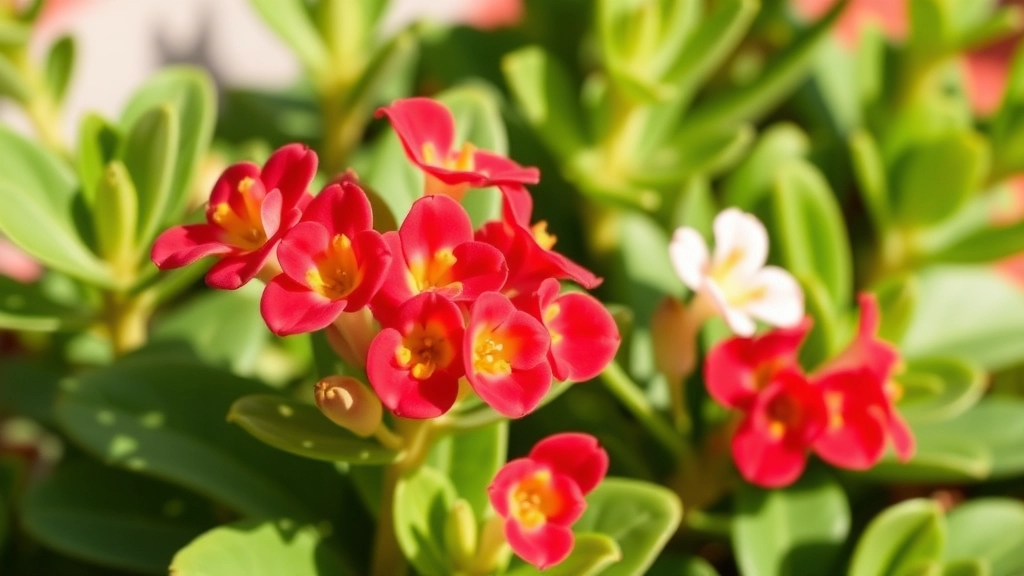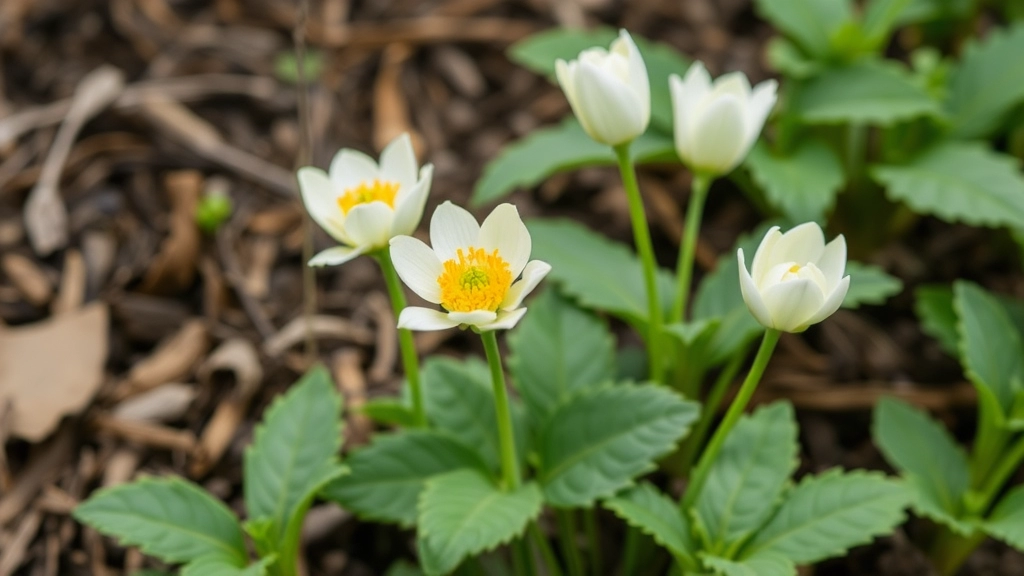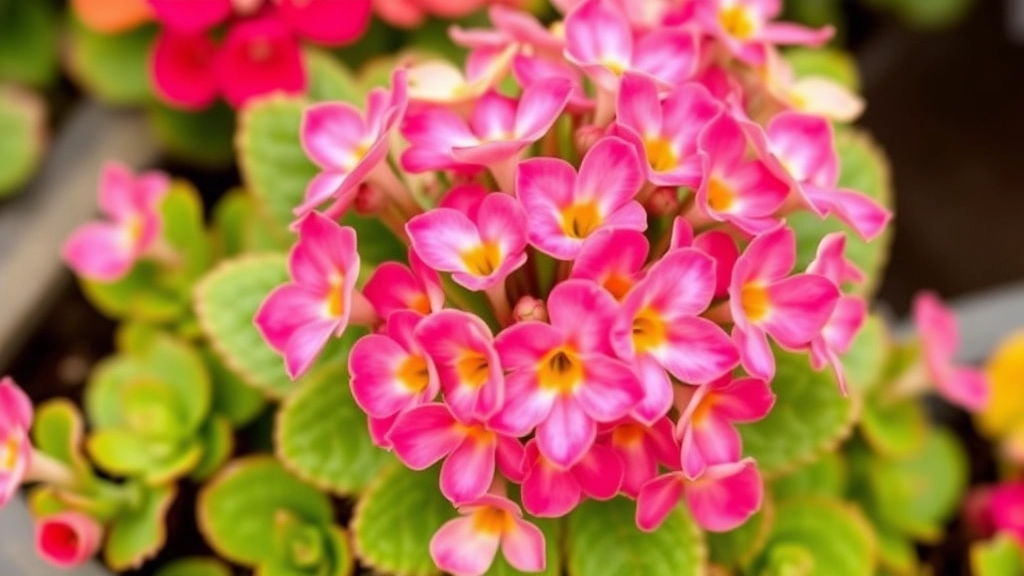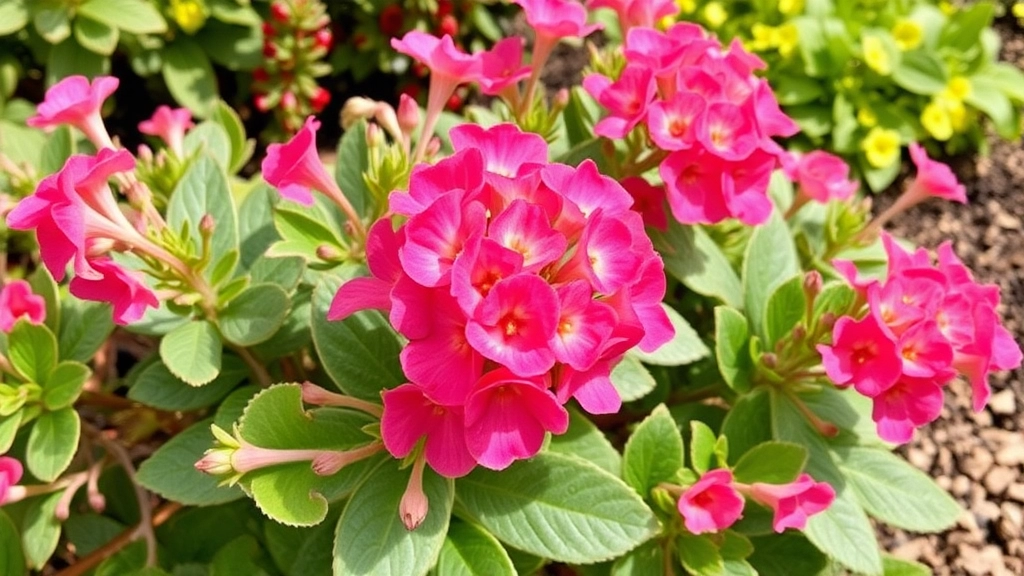Kalanchoe Flowering Season
When it comes to the Kalanchoe flowering season, understanding the natural blooming period is key. Typically, these vibrant plants bloom during the winter months, offering a splash of colour when most other plants are dormant. To ensure your Kalanchoe thrives and blooms beautifully, it’s essential to consider environmental factors such as light exposure, temperature, and watering routines.
Encouraging Reblooming
Encouraging your Kalanchoe to rebloom indoors can be a rewarding experience. By simulating dormant periods and adjusting care routines seasonally, you can maximise the bloom duration. Pay close attention to light conditions, as they play a crucial role in the flowering process. With the right care, your Kalanchoe can continue to brighten your space with its stunning flowers year-round.
Natural Blooming Period of Kalanchoe
Are you wondering when your Kalanchoe will burst into bloom?
Understanding the natural blooming period of Kalanchoe is essential for any plant enthusiast looking to enjoy these vibrant flowers.
Typically, Kalanchoe plants bloom during the late winter to early spring months.
This period aligns with their natural growth cycle, allowing them to thrive and showcase their stunning clusters of flowers.
Key Points About Kalanchoe Blooming:
- Blooming Season: Late winter to early spring.
- Duration: Flowers can last several weeks to months with proper care.
- Varieties: Different Kalanchoe species may have slight variations in blooming times.
During this blooming phase, the plant utilizes its stored energy to produce flowers, making it crucial to provide optimal care leading up to this period. For more detailed tips, check out our guide on making your Kalanchoe flower again and explore tips for optimal blooms across different Kalanchoe species.
Environmental Factors Affecting Kalanchoe Flowering

Ever wondered why your Kalanchoe isn’t blooming as beautifully as you hoped? You’re not alone. Many plant lovers face this issue, and it often boils down to environmental factors.
Light Exposure
First off, light is crucial. Kalanchoes love bright, indirect sunlight. If they don’t get enough light, they may not flower at all.
- Ideal Conditions: Aim for 12-14 hours of light daily.
- Signs of Insufficient Light: Stretched-out stems and fewer blooms.
Temperature
Next, temperature plays a big role. Kalanchoes thrive in warmer conditions but can be sensitive to extremes.
- Optimal Range: Between 20-25°C (68-77°F) during the day.
- Watch Out For: Sudden temperature drops below 10°C (50°F) can shock them.
Humidity Levels
Humidity might not be the first thing you think about, but it matters!
- Ideal Humidity: Moderate levels, around 40-60%.
- Too Dry? This can lead to crispy leaves and fewer flowers. Consider misting or using a pebble tray.
Soil Quality
The right soil mix is essential for healthy blooms.
- Best Mix: A well-draining potting mix, preferably one designed for succulents.
- Signs of Poor Soil: Yellowing leaves or root rot can indicate your soil isn’t up to scratch.
Watering Practices
Finally, let’s chat about watering. Overwatering is a common mistake.
- Watering Tips: Allow the top inch of soil to dry out before watering again.
- Signs of Overwatering: Wilting or mushy stems can signal trouble.
To successfully encourage your Kalanchoe to rebloom indoors, consider the following strategies:
– **Pruning**: After the flowers have faded, trim the spent blooms and any leggy growth. This helps redirect energy back into the plant, promoting new growth and blooms.
– **Light Exposure**: Ensure your Kalanchoe receives bright, indirect sunlight. A south-facing window is ideal. Insufficient light can hinder blooming, so consider rotating your plant to maintain even exposure. For more tips on lighting and care, you can refer to the [fixing etiolated Kalanchoe Blossfeldiana](https://planthq.org/fixing-etiolated-kalanchoe-blossfeldiana-lighting-and-care-tips/) guide.
– **Watering Routine**: Allow the soil to dry out between waterings. Overwatering can lead to root rot, while underwatering can stress the plant. Aim for a balanced approach.
– **Fertilization**: Use a balanced, water-soluble fertiliser every few weeks during the growing season. Look for a fertiliser with a higher phosphorus content to encourage flowering.
– **Temperature Control**: Kalanchoe prefers warmer temperatures, ideally between 20-25°C (68-77°F). Avoid placing it near drafts or heating vents.
– **Dark Periods**: To stimulate blooming, provide the plant with 14-16 hours of darkness each night. This mimics its natural blooming cycle and encourages flower production. For a comprehensive guide on care, you might find the [ultimate guide to flowering Kalanchoe care](https://planthq.org/ultimate-guide-to-flowering-kalanchoe-care-tips-for-blooming/) very useful.
How to Simulate Dormant Periods for Better Flowering

After understanding the importance of environmental factors in Kalanchoe flowering, let’s delve into how simulating dormant periods can enhance their blooming potential.
Many Kalanchoe enthusiasts often find themselves wondering why their plants aren’t producing flowers as expected. One effective strategy is to mimic the natural dormancy period that these plants experience in the wild. Here’s how to do it:
- Reduce Watering: Gradually cut back on watering during the fall and winter months. This helps signal to the plant that it’s time to rest. Aim for a watering schedule that allows the soil to dry out completely between sessions.
- Lower Temperatures: Kalanchoe thrives in cooler temperatures during dormancy. Keep your plant in a location where temperatures hover between 10-15°C (50-59°F). This cooler environment encourages the plant to enter a restful state.
- Limit Fertilization: During the dormant phase, refrain from fertilizing your Kalanchoe. This allows the plant to conserve energy rather than expending it on growth.
- Provide Dark Conditions: Kalanchoe requires less light during dormancy. Consider placing your plant in a darker area for a few weeks. This mimics the shorter days of winter.
- Duration of Dormancy: Aim for a dormancy period of about 4-6 weeks. This duration is typically sufficient for the plant to recharge and prepare for the blooming season.
By implementing these strategies, you can effectively simulate a dormant period for your Kalanchoe, setting the stage for a vibrant blooming season ahead.
Seasonal Care: Adjusting Watering and Fertilizing
As we explore the intricacies of Kalanchoe care, it’s essential to understand how seasonal changes impact watering and fertilizing routines.
Watering Adjustments
Spring/Summer:
- During the growing season, Kalanchoe thrives and requires more water.
- Water when the top inch of soil feels dry.
- Ensure pots have drainage holes to prevent root rot.
Autumn/Winter:
- Reduce watering as the plant enters dormancy.
- Water less frequently, allowing the soil to dry out completely between sessions.
- Overwatering in winter can lead to wilting and other issues.
Fertilizing Guidelines
Spring/Summer:
- Use a balanced, water-soluble fertilizer every 4-6 weeks.
- Focus on a formula high in potassium to encourage blooming.
Autumn/Winter:
- Cease fertilization during the dormant period.
- This allows the plant to conserve energy and prepare for the next blooming cycle.
Key Takeaways
Importance of Light Conditions in Different Seasons

Ever wondered why your Kalanchoe seems to thrive one season and struggle the next?
The answer often lies in the light conditions.
Light is crucial for Kalanchoe flowering. It’s not just about keeping them alive; the right light can make or break those beautiful blooms.
Seasonal Light Needs
- Spring and Summer:
- These seasons are all about long, bright days.
- Kalanchoe loves direct sunlight for at least 6 hours a day.
- A south-facing window is a perfect spot.
- Autumn and Winter:
- Days get shorter, and so does the light.
- You might need to supplement with grow lights if natural light is lacking.
- Aim for about 12-14 hours of light to mimic those longer days.
Tips for Optimal Light Exposure
- Rotate your plant: This ensures all sides get equal light.
- Watch for signs: If your Kalanchoe is stretching or leaning, it’s craving more light.
- Avoid drafts: Keep them away from cold windows during winter.
I remember when I first got my Kalanchoe. It was blooming beautifully in spring, but by winter, it looked sad and droopy. A quick adjustment to its light conditions made all the difference!
Getting the light right isn’t just about keeping your plant healthy; it’s key to encouraging those vibrant flowers.
Common Flowering Problems and Solutions
As we delve deeper into the care of Kalanchoe, it’s essential to address the common flowering problems that can hinder your plant’s beautiful blooms. Many Kalanchoe enthusiasts often face these issues, which can be frustrating. Let’s explore these challenges and their straightforward solutions.
1. Lack of Flowers
Problem:
One of the most common concerns is when your Kalanchoe refuses to bloom.
Solutions:
- Ensure Adequate Light: Kalanchoe thrives in bright, indirect sunlight. If it’s not receiving enough light, consider relocating it closer to a window.
- Check Watering Routine: Overwatering can lead to root rot, while underwatering can stress the plant. Aim for a balanced watering schedule.
- Fertiliser Needs: A lack of nutrients can stunt blooming. Use a balanced fertiliser during the growing season to encourage flower development.
2. Wilting Flowers
Problem:
Flowers wilting prematurely can be disheartening.
Solutions:
- Monitor Water Levels: Ensure your plant is neither too dry nor too soggy. A consistent watering schedule is key.
- Humidity Levels: Kalanchoe prefers moderate humidity. If your home is too dry, consider misting the plant occasionally or using a humidity tray.
3. Discolouration of Blooms
Problem:
If your blooms are turning yellow or brown, this can indicate stress.
Solutions:
- Adjust Light Exposure: Too much direct sunlight can scorch the flowers. Move the plant to a location with filtered light.
- Inspect for Pests: Check for signs of pests like aphids or mealybugs. If found, treat with insecticidal soap or neem oil.
4. Short Blooming Period
Problem:
Experiencing a brief blooming period can be disappointing.
Solutions:
- Simulate Dormancy: Follow a dormancy period by reducing watering and fertilisation after blooming ends. This helps the plant gather energy for the next bloom cycle.
- Seasonal Adjustments: As seasons change, adjust your care routine accordingly to ensure optimal conditions for flowering.
Maximizing Bloom Duration for Kalanchoe Plants

So, you’ve got your Kalanchoe blooming beautifully, but how do you keep those vibrant flowers around for as long as possible?
It’s a common concern for many plant lovers. We all want our plants to shine, but sometimes they just don’t last as long as we’d hope.
Here’s how to help your Kalanchoe keep blooming longer:
- Optimal Watering:
- Water when the top inch of soil feels dry.
- Avoid overwatering; soggy soil can lead to root rot.
- Fertilizing Wisely:
- Use a balanced, water-soluble fertilizer every 4-6 weeks during the growing season.
- A high potassium fertilizer can boost blooming.
- Pruning Dead Flowers:
- Snip off spent blooms as soon as they fade.
- This encourages the plant to focus energy on new growth.
- Temperature Control:
- Keep your Kalanchoe in a spot with temperatures between 18-24°C.
- Avoid drafts or sudden temperature changes.
- Light Exposure:
- Ensure it gets plenty of bright, indirect sunlight.
- Too little light can shorten the blooming period.
- Humidity Levels:
- Kalanchoe prefers moderate humidity.
- If your home is dry, consider misting occasionally.
By following these tips, you can extend the blooming period of your Kalanchoe, making your space feel even more vibrant and lively.
Outdoor vs. Indoor Kalanchoe Flowering Differences
When it comes to Kalanchoe flowering, many plant enthusiasts wonder about the differences between outdoor and indoor growth.
Outdoor Kalanchoe Flowering
Growing Kalanchoe outdoors can lead to vibrant blooms, thanks to the natural sunlight and environmental conditions. Here are some key points to consider:
- Sunlight Exposure: Outdoor Kalanchoe typically receives full sun, which promotes healthy growth and abundant flowers.
- Natural Pollinators: Being outside means access to bees and other pollinators, which can enhance flowering.
- Temperature Variability: Outdoor plants experience seasonal changes in temperature, which can trigger blooming cycles.
Indoor Kalanchoe Flowering
Indoor Kalanchoe, on the other hand, presents its own set of challenges and advantages:
- Controlled Environment: Indoors, you can control temperature and humidity, creating an optimal environment for flowering.
- Light Limitations: Indoor plants may not receive enough natural light, particularly in winter, which can hinder blooming.
- Watering Practices: Indoor Kalanchoe requires careful watering to avoid overwatering, a common issue that can lead to root rot.
Key Differences to Note
- Light Requirements: Outdoor Kalanchoe thrives in direct sunlight, while indoor plants may need supplemental grow lights.
- Temperature Fluctuations: Outdoor plants benefit from seasonal changes, whereas indoor plants need consistent conditions to encourage flowering.
- Pest Management: Outdoor Kalanchoe may face pests like aphids, while indoor plants might struggle with issues like spider mites due to dry air.
For more detailed information on how to care for your Kalanchoe, check out our ultimate guide to growing and caring for succulent plant Kalanchoe and learn the best care tips for flowering Kalanchoe succulents.
FAQs on Kalanchoe Flowering Season
Why isn’t my Kalanchoe blooming?
Several environmental factors could be affecting your Kalanchoe’s ability to bloom. These include inadequate light exposure, improper temperature, low humidity levels, poor soil quality, and incorrect watering practices.
What are the ideal light conditions for Kalanchoe to flower?
Kalanchoes thrive in bright, indirect sunlight. Aim for 12-14 hours of light daily. During spring and summer, direct sunlight for at least 6 hours a day is beneficial, while in autumn and winter, you might need to supplement with grow lights.
How does temperature affect Kalanchoe flowering?
Kalanchoes prefer temperatures between 20-25°C (68-77°F) during the day. Sudden temperature drops below 10°C (50°F) can shock the plant and hinder flowering.
What humidity levels are best for Kalanchoe?
Moderate humidity levels around 40-60% are ideal for Kalanchoe. If the air is too dry, it can lead to crispy leaves and fewer flowers. Consider misting the plant or using a pebble tray to maintain proper humidity.
What type of soil is best for Kalanchoe?
A well-draining potting mix, preferably one designed for succulents, is essential for Kalanchoe. Poor soil quality can lead to yellowing leaves or root rot, affecting the plant’s ability to bloom.
How should I water my Kalanchoe to encourage blooming?
Allow the top inch of soil to dry out before watering again. Overwatering can lead to wilting or mushy stems, which can prevent the plant from flowering.
How can I simulate a dormant period for my Kalanchoe?
To mimic the natural dormancy period, reduce watering, lower temperatures to 10-15°C (50-59°F), limit fertilization, and provide dark conditions for about 4-6 weeks. This helps the plant recharge and prepare for the blooming season.
How can I maximize the bloom duration of my Kalanchoe?
Ensure optimal watering by letting the top inch of soil dry out before watering. Use a balanced, water-soluble fertilizer every 4-6 weeks during the growing season. Prune dead flowers, maintain temperatures between 18-24°C, provide bright, indirect sunlight, and keep humidity levels moderate.
Why does my Kalanchoe thrive in one season but struggle in another?
Kalanchoe’s light needs vary by season. In spring and summer, they need direct sunlight for at least 6 hours a day. In autumn and winter, shorter days mean you might need to supplement with grow lights to maintain 12-14 hours of light.
References
-
Why Is My Kalanchoe Not Blooming?
-
Kalanchoe Plant Care
-
Kalanchoe: How to Care for a Kalanchoe Plant
